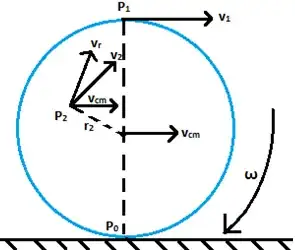A small doubt in rolling motion. As we know, for pure rolling, the velocity of the lowermost point has to be zero wrt the ground or whatever platform it may be on. Suppose, we have a body (let's say a ring) and it has velocity $v_0$. Assuming the floor has friction, which serves as the torque to cause rolling. I want to find the velocity of the ring after pure rolling has been achieved. My initial thoughts were with the law of conservation of angular momentum on the lowermost point as the net torque about the lowermost point would be zero.
So would the expression be as follows:
$$M v_0 R = M v R + I(\text{centreofmass})\omega$$
or
$$M v_0 R = M v r + I(\text{axis about the lowermost point})\omega$$
My book says it's the former, but I'm a little confused why. In general, for any rotational motion questions if we have to use an axis (not about the one the body is rotating in), would we use the $I$ about its rotational axis or the axis we have taken for the sake of the question. Attaching a pic of a rolling body, in case it helps.
